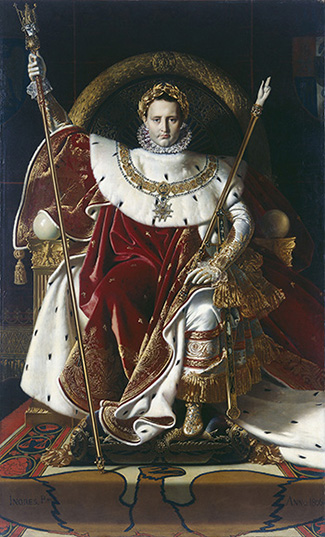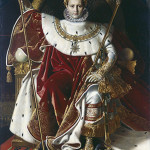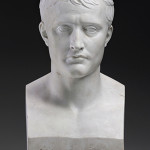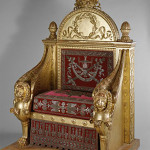By JACQUELINE HOUTON
The idea that all art is propaganda captured quite a few devotees during the 20th century. Seen in writings of George Orwell, Upton Sinclair, and W.E.B. Du Bois, this sentiment would be further refined later in the century by French philosopher Jacques Ellul, who reacted to the unprecedented proliferation of mass media technologies with the assertion that the goal of modern propaganda “is no longer to transform opinion, but to arouse an active and mythical belief.” Yet an exhibition currently on display at the Museum of Fine Art suggests that this dynamic was at play long before the emergence of radio, television, or the Internet—that it may have flowered during the reign of a man who commanded the largest army Europe had ever seen, but who insisted that “Imagination rules the world,” not the rifle or the cannon. The two hundred artworks and artifacts on display in Symbols of Power: Napoleon and the Art of the Empire Style, 1800-1815 show how the aesthetic sensibilities of an age are shaped by historical shifts in ideology. The exhibit reveals that the power of the state can be felt not only in the political realm but in the artistic and domestic ones as well: its influence extends to wallpaper and wash basins as well as commissioned paintings, to the dresses worn by women whose names have been long forgotten as much as the robes of an emperor.
Napoleon rose to prominence as a general during the French Revolution, and the exhibit rightly begins by examining the artistic tropes of the tumultuous years that preceded his reign. Reacting against the perceived excesses of the monarchy and aristocracy, revolutionary-era craftsmen rejected the rococo style that had dominated so much of the eighteenth century, opting instead for clean lines and sturdy, symmetrical forms that harkened back to the simplicity of classical designs. Their focus on function meant that when ornamentation did appear, it had to have meaning, and the text accompanying the collection’s early pieces reveals that what appear to be mere decorative flourishes were in fact emblems of the regime’s ideals of liberté, equalité, fraternité. The red-and-blue upholstery on one straight-backed chair, built between 1791 and 1794, bears the colors of the city of Paris, the birthplace of the revolution and the seat of government after power had been seized from Versailles. Also incorporated into the chair’s design are red Phrygian caps; originally worn by freed slaves in ancient Rome, the cap was adopted as an emblem of liberty.
Indeed, French culture was captivated by all things classical: seeking to create a public mythos for their new republic, the revolutionaries turned to Greece and Rome, the progenitors of participatory government, as the source for a symbolic language that is enacted endlessly on the collection’s clocks and cupboards, tea tables and tapestries. The classical craze can also be seen in the fashions of the time. Gone were the confining corsets and voluminous hoop skirts that had been so popular in Louis XVI’s extravagant court, replaced by gowns of a simpler Grecian look: four out of the five dresses on display feature empire-waisted sheaths of thin white cotton, with slightly puffed sleeves and a bit of embroidery providing their only adornment. Napoleon would co-opt this trend towards the sober and stately in the art and décor he amassed, though as his reign went on, the materials used to make them became more and more opulent—Empire style may be more free of frippery than the baroque mode that preceded it, but there’s still enough gleaming gold and polished marble in this exhibit to give you eyestrain.
Napoleon took the post-revolution fascination with classicism and ran with it, but because his aim was to legitimize his imperial ambitions, his emphasis was on Caesar, not the Senate. The master spin-doctor mined the past for yet another set of symbols. Winged thunderbolts—the favored weapons of Jupiter, the Romans’ chief god—decorate his golden throne. Golden eagles, which appeared on Roman military regalia and were also associated with Jupiter, are stitched onto his lavish purple robe. Bees were another of Napoleon’s favorite motifs, and 28 of them frame his monogram in the center of the enormous carpet that once covered his throne room. The bee was his answer to the Bourbon’s fleur-de-lis, but this symbol actually alluded not to any Roman god or ruler but to the earliest French kings; it was safer for Napoleon to associate himself with them than with France’s more recent monarchs, the last of whom lost his head for his perceived tyranny and love of luxury. Napoleon certainly indulged in these sins too, but he managed to postpone his fall by cultivating a cult of personality, associating his personal glory with the strength of the state. Consider Jean-Auguste-Dominique Ingres’s arresting 1806 portrait, “Napoleon I on His Imperial Throne,” which lends the new emperor all the prestige of the rulers of both ancient Rome and early France. Clad in a magnificent robe of white ermine and burgundy velvet, a larger-than-life Napoleon sits in his throne, wearing a crown of golden laurel leaves like a Roman emperor and holding a replica of Charlemagne’s scepter. Image is as important as the size of your army if you’re going to keep a continent under your thumb, and Ingres nearly deifies Napoleon, depicting him as man made to rule—maybe even a man worth dying for.
Another instance of painting as PR vehicle is seen in Auguste Hyacinthe Debay’s 1823 “General Bonaparte Visiting the Plague-Stricken at Jaffa,” a version of Antoine-Jean Gros’s 1804 work on the same theme that was first exhibited at the time of Napoleon’s coronation. The romantically styled scene shows the general fearlessly comforting his plague-suffering soldiers while other officers hang back or cover their mouths with their handkerchiefs. Highlighted by sunshine on a largely shadowy canvas, Napoleon appears almost Christ-like, reaching out as though the touch of his ungloved hand could heal the sick. The stirring painting—an attempt to put a positive spin on Napoleon’s failed effort to “liberate” the Middle East—must have made a powerful piece of propaganda (it certainly evokes more of an emotional response than any “Mission Accomplished” banner). The text accompanying the painting notes that the Jaffa campaign was disastrous, though it doesn’t mention the specifics that make the work so ironic: Napoleon was in such a haste to retreat that he slaughtered thousands of prisoners-of-war and even ordered the poisoning of dozens of his own plague-stricken soldiers. The successful campaigns that created Napoleon’s vast empire also came at a great cost, for his wars left several million dead. The populace had to believe that the years of warfare were worthwhile, and thus it is unsurprising that so many of the pieces dating from the first decade of the 19th century—like the stool whose cushion rests between two pairs of crossed sabers—feature motifs extolling military might. That even some of the housewares on display are adorned by shields, swords, and helmets shows that Napoleon’s battle for hearts and minds began at home.
A respite from all this warmongering, and from the predominantly masculine feel of Empire style, comes courtesy of a few exhibition rooms that are devoted to the era’s depictions of romance and femininity. Scenes from the mythical love story of Cupid and Psyche adorn a boat-bed and other bedroom furnishings. Womanly symbols, like butterflies, dolphins, flowers, and swans—two of which form the arm supports of the red-velvet chair that sat in Empress Josephine’s boudoir—appear in décor from dressing and drawing rooms. However, a larger narrative fails to rise from this portion of the exhibit, perhaps because it never becomes clear what roles Napoleon’s wives and other women played during this age of conquest. Overall though, Symbols of Power does a good job of contextualizing the diverse pieces in its collection, revealing the meaning beneath all that beauty. It is fascinating to see how quickly an aesthetic inspired by ideals of liberty and equality can be adapted to promote autocracy and jingoism. If only every history lesson could sweep us off our feet.
- Jean-Auguste-Dominique Ingres, Napoleon I on His Imperial Throne (Napoleon Enthroned),, Oil on canvas, 1806, 260 x 163 cm. Musée de l’Armée, Paris (inv. 4, Ea 89/1), Courtesy of the American Federation of Arts.
- Sevres Manufactory (after Antoine-Denis Chaudet), Bust of Napoleon I, Hard-paste biscuit porcelain, 1806. Museum of Fine Arts, Boston. Gift of Randolph J. Fuller, Mrs. Caleb Loring, John L. Gardner, G. Peabody and Rose Gardner Charitable Trust, and Mary S. and Edward J. Holmes Fund. Photograph © Museum of Fine Arts, Boston.
- François-Honoré-Georges Jacob-Desmalter, Throne, Carved, and gilded wood, covered in red velvet with silver embroidery, 1805, 160 x 110 x 82 cm . Embroidery by Picot, Designed by Bernard Poyet. Musée des Arts Décoratifs, Paris (14421 A), Courtesy of the American Federation of Arts.
"Symbols of Power: Napoleon and the Art of Empire Style: 1800-1815" is on display until January 27th, at the Museum of Fine Arts, Boston, located at 465 Huntington Ave.
All images are courtesy of the Museum of Fine Arts, Boston.
(The exhibition is organized by the American Federation of Arts, New York, and Les Arts Décoratifs, Paris. The national tour is made possible, in part, by the Joseph and Sylvia Slifka Foundation, Inc., and the Samuel H. Kress Foundation. The exhibition is also supported by an indemnity from the Federal Council on the Arts and the Humanities.)







